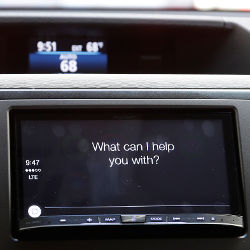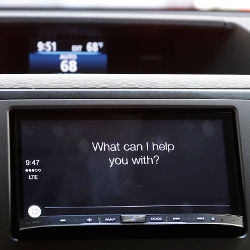
Over the last quarter-century, automobiles have evolved into increasingly sophisticated—and computerized—machines. Today, some motor vehicles contain upward of 100 electronic control units with microprocessors that manage everything from steering and braking to navigation, climate control, and entertainment. They also have hundreds of millions of lines of software code. Overseeing the tangle of systems—and integrating buttons, knobs, voice commands and more—has emerged as a growing challenge, particularly as consumers carry smartphones into cars and look to integrate all these systems and controls seamlessly.
“There is a huge challenge associated with providing a driver with the right amount of information at the right time. You don’t want to overwhelm a driver or have someone get to the point where they are distracted or tuning out crucial information,” says Sam Abuelsamid, senior analyst on the Transportation Efficiencies Team at Navigant Research, which closely tracks automobile technologies. In recent years, auto manufacturers have introduced apps, speech recognition, and other systems, but often with limited success. “While these systems have delivered extra features to drivers, they’ve been limited in capabilities and the user interfaces have been relatively clunky,” he notes.
“You don’t want to overwhelm a driver or have someone get to the point where they are distracted or tuning out crucial information.”
As a result, many consumers have thrown up their hands (but not while driving) and given up on using these systems. Instead, they prefer to tap into their smartphones and the simple, familiar interfaces they provide as the hub for infotainment and other functions. As John Maddox, assistant director of the Michigan Transportation Center at the University of Michigan, puts it: “Consumers have become enamored by the breadth, variety, and timeliness of information they get on their phone, and they are now expecting this level of information in a vehicle. In some cases, they want the same display and the same choices built into their car.”
The upshot? As automobiles and computing roll forward and distracted driving becomes an ever-greater concern, automakers are looking for ways to integrate all these systems effectively and add advanced technology features, while Apple and Google are introducing infotainment platforms for vehicles. “We are moving past an era where features and capabilities have been thrown into cars, to a new environment that supports a connected lifestyle,” observes Mark Boyadjis, senior analyst and manager of infotainment and Human Machine Interface at automotive research and consulting firm IHS Automotive. “We will see a huge transformation in vehicles over the next few years.”
Beyond the Dashboard
Although GPS-based automobile navigation systems and other advanced technology features have been around since the early 1990s, a new era of automobile infotainment systems began around 2007, when Ford announced the first integrated, in-vehicle communications and entertainment system, SYNC. It allowed motorists to make hands-free phone calls with their cellular phones and to control music and other functions with specialized controls, including voice commands, activated by tapping a button on the steering wheel. Over the next few years, other automobile makers introduced similar systems, typically built on Microsoft’s Embedded Automobile System or Blackberry’s QNX software platform, which is used for critical systems such as air traffic controls, surgical equipment, and nuclear power plants.
Unfortunately, many of these early systems were difficult to use, and some relied on highly specialized and, at times, cryptic voice commands rather than natural language. In fact, J.D. Power reports the number-one disappointment of new car buyers is the voice recognition function. These systems also did not integrate well with iPods and emerging iPhones. Even with a built-in USB connection or Bluetooth connectivity, it was difficult, if not impossible, to view or control a music playlist or see information about a song, for example. In addition, these early systems could not pull contact information directly from a smartphone, making it necessary for a motorist to program in phone numbers and addresses manually.
By 2010, Ford had introduced AppLink and Chevrolet introduced My-Link—and other auto companies, including Audi and Volvo, soon followed suit with tighter integration with iPhones or similar controls accessible from a vehicle’s LCD display or, in some cases, from a smartphone app. Yet, as Abuelsamid puts it: “These systems were a step forward, but consumers still found them confusing and clunky. There was a need for a platform that could tie together all the various tools, technologies, and other elements effectively.”
In 2013, Apple introduced a new concept: an interface and software driver layer that runs on top of QNX and other real-time vehicle operating systems. Apple’s CarPlay, and the subsequent introduction of Google’s Android Auto, allow motorists to pair their mobile devices with a vehicle and view a simplified phone interface on the car’s display screen, with a limited number of icons. “Anyone that is comfortable with the phone should be immediately comfortable with the interface,” Abuelsamid explains.
For automakers, the appeal of CarPlay and Android Auto is that they essentially adapt to whatever vehicle they are in. This might include a Mercedes with a non-touchscreen system and knob controls on the center console, a Ferrari with a resistive touchscreen interface, or a Volvo with a capacitive touchscreen interface. In every instance, the software translates the relevant hardware signals into a form the phone recognizes. Moreover, these platforms allow manufacturers to move away from proprietary systems and let consumers use either Android or iOS devices in their car—and even to switch between them. “It eliminates a basic problem: every car is different and it’s difficult to operate a car you’re not familiar with. It introduces a standard interface,” Boyadjis says.
Convenience and happier motorists are not the only goals, however. According to the Virginia Tech Transportation Institute’s Center for Automotive Safety, 80% of all crashes and 65% of all near-crashes involve a motorist looking away from the forward roadway within three seconds of the event. CarPlay and Android Auto aim to minimize driver distraction. For example, the phone’s screen goes dark when the automobile is running, and these systems do not support social media or video. In addition, Android Auto has no “back” or “recents” buttons. Finally, both platforms offer better speech recognition through Siri and Google Now, which off-load processing to the cloud.
Says Jim Buczkowski, Henry Ford technical fellow and director for electrical and electronic systems in Ford’s Research and Innovation Center, “A key is understanding what to process onboard and what to process in the cloud. The experience must be seamless and consistent, even when there isn’t 100% cloud availability.”
Driving Forward
Automotive infotainment systems are only part of the story, however. The J.D. Power 2015 U.S. Tech Choice Study found consumers increasingly seek technology that makes driving safer. Blind-spot detection and collision-avoidance systems, night vision, and other enhanced features ranked highest among desired technologies. Many high-end cars now include these features. Automakers are experimenting with head-up displays that project text and graphics on an area of the windshield. In addition, Texas Instruments is developing a projection system that uses digital light processing and interpolation methods to produce clear images across a windshield, even in poor weather or at night. The critical factor? “An HUD that displays information or alerts has to work with a quick glance and allow a person’s eyes to remain upward and forward,” Ford’s Buczkowski says.
Today, separate computerized systems in a vehicle typically use dedicated electronic controllers. Future automobiles will begin to combine and connect these systems, including GPS, cameras, radar, lidar, and more, Abuelsamid says. “They will be tied together through a vehicle network that will allow data sharing and introduce new and more advanced capabilities. This is a step toward automated driving systems.” General Motors has announced support for “Super Cruise” control in the 2016 Cadillac CT6; the technology will enable hands-free lane following and automatic braking and speed control during highway driving.
Critical to engineering these next-generation vehicles is embedding robust but highly secure communications systems. Researchers have already demonstrated the ability to hack into vehicles and take control of steering wheels and brakes. Informatics systems pose additional risks.
As a result, some auto manufacturers are now building Ethernet into vehicles in order to tie together all the various onboard systems in a more secure way. In addition, the automotive industry is developing a dedicated short-range wireless communications protocol called 802.11p, and some are also building LTE cellular connectivity directly into vehicles. This makes vehicle-to-vehicle and vehicle-to-infrastructure communications possible, along with advanced certificate management and support for enhanced security features, including data encoding and encryption. Ford’s Buczkowski says this could ultimately lead to far more innovative features, including, for example, cars that can “see” around corners by communicating with other vehicles, and using their onboard systems to spot a cyclist or pedestrian. The network might also deliver an alert to the pedestrian through a smartwatch that vibrates or a smartphone that emits an alarm. “Mobility and cloud computing will play important roles in defining future driving experiences,” he says.
Some automakers are now building Ethernet into vehicles in order to tie together all the various onboard systems in a more secure way.
These communications capabilities will prove nothing less than transformative, Boyadjis says. Today, a two-year old car seems outdated, “but when you build a platform that allows infotainment systems and other onboard systems to update over the air, you enter an entirely different realm.” For instance, automaker Tesla has instantly updated more than 30,000 vehicles over the air. “In the future, it will be possible to add features and improve safety for power train, braking systems, steering controls, and other components through real-time software updates.” Adds Buczkowski: “Cars will add new features and address deficiencies or shortfalls based on customer feedback. It will likely be a very similar model as today’s smartphones.”
To be sure, greater technology integration will radically redefine the automobile and the driving experience over the next few years. In a decade, cars and their interiors may not resemble what we drive today. Concludes Abuelsamid: “We may at some point see reprogrammable touch interfaces that allow vehicle consoles and interfaces to appear the same way, regardless of the vehicle. We may see NFC tags that recognize you and adapt the car automatically. When you migrate to a software-based platform, all sorts of ideas become possible.”
Further Reading
Gharavi, H., Venkatesh, K., and Petros Ioannou, P.
Scanning Advanced Automobile Technology, Proceedings of The IEEE – PIEEE, vol. 95, no. 2, pp. 328–333, 2007, http://1.usa.gov/1b7sFMO
Alt, F., Kern, D., Schulte, F., Pfleging, B., Sahami Shirazi, A., and Schmidt, A.
Enabling micro-entertainment in vehicles based on context information, Proceedings of the 2nd International Conference on Automotive User Interfaces and Interactive Vehicular Applications, 2010. Pages 117–124. http://dl.acm.org/citation.cfm?id=1969794
Steinbach, T.
Real-time Ethernet for automotive applications: A solution for future in-car networks, Consumer Electronics – Berlin (ICCE-Berlin), 2011 IEEE International Conference, September 6-8, 2011, Pages 216–220. http://bit.ly/1Efgbxf
Huang, Y., Qin, G. H., Liu, T., and Wang, X. D.
Strategy for Ensuring In-Vehicle Infotainment Security, Applied Mechanics and Materials, Vols. 556-562, pp. 5460–5465, May 2014. http://www.scientific.net/AMM.556-562.5460






Join the Discussion (0)
Become a Member or Sign In to Post a Comment